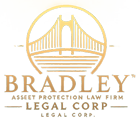For real estate investors and high-net-worth individuals, asset protection is a must—but many hesitate, wondering: “Will setting up an asset protection structure impact my tax benefits, like depreciation?”
The short answer? No. Our asset protection planning is tax-neutral, meaning your ability to offset income with depreciation remains unchanged. However, it’s essential to understand how passive and active income rules apply to ensure you’re maximizing tax efficiency while keeping your assets safe.
What Does “Tax Neutral” Mean in Asset Protection?
When we set up an Asset Management Limited Partnership (AMLP) and Bridge Trust®, we do so with tax neutrality in mind. This means:
• Your tax situation remains the same as if the asset were held in your personal name or a standard LLC.
• Depreciation, deductions, and other tax benefits remain intact.
• The IRS treats the income and losses exactly the same—passive income rules still apply.
How Is Real Estate Structured Inside the Asset Protection Plan?
When structuring an asset protection plan for real estate, the property is held in a disregarded LLC, which flows up into the Asset Management Limited Partnership (AMLP).
• The LLC remains disregarded for tax purposes, meaning all tax benefits, including depreciation deductions, flow through just as they would without an asset protection plan.
• The AMLP acts as a management company, providing a crucial legal separation between you and your assets.
• The Bridge Trust® holds the AMLP in case of a worst-case legal scenario, offering offshore-level strength with domestic control.
This structure ensures that while your assets are legally protected, your tax benefits remain untouched.
How Depreciation Works in an Asset Protection Structure
Depreciation is a powerful tool for real estate investors, allowing them to reduce taxable income by deducting a portion of their property’s value over time. But will moving real estate into a stronger legal structure take away that benefit?
🔹 Example Scenario:
Let’s say John, a successful real estate investor, owns several rental properties through an LLC. He relies on depreciation to offset rental income and lower his tax liability.
👉 John decides to strengthen his asset protection by moving his LLC under an Asset Management Limited Partnership (AMLP), with the AMLP then being owned by a Bridge Trust®.
What changes?
✅ Depreciation Still Applies – The IRS still recognizes John as the taxpayer benefiting from depreciation, just as he did before.
✅ Passive Income Rules Still Apply – John can offset passive rental income, but he can’t use depreciation to offset W-2 or business income unless he qualifies as a real estate professional under IRS rules.
✅ Tax Reporting Remains the Same – His CPA continues filing taxes as before, with no additional tax complexity.
What doesn’t change?
❌ Depreciation doesn’t suddenly apply to active income—IRS rules on passive vs. active income still apply.
❌ John doesn’t lose tax benefits—his asset protection structure shields his wealth without interfering with tax advantages.
Understanding Passive vs. Active Income Rules
While depreciation remains intact in an asset protection plan, it’s still subject to standard IRS passive activity loss (PAL) rules:
• Passive losses (like real estate depreciation) can only offset passive income.
• Active income (like W-2 wages or business earnings) cannot be offset by passive losses—unless the taxpayer qualifies as a real estate professional under IRS guidelines.
This means:
• If you’re a passive investor, depreciation will only offset rental income, not your salary or business earnings.
• If you qualify as a real estate professional, depreciation can offset active income, regardless of your asset protection structure.
Why High-Net-Worth Individuals Need Both Asset Protection & Tax Strategy
Many real estate investors and business owners mistakenly believe that an LLC alone provides adequate protection. But without additional legal layers like an AMLP and Bridge Trust®, creditors can still access your wealth.
🔹 An LLC is NOT Enough:
• Courts can pierce the corporate veil if the LLC is not maintained properly.
• Charging order protection is weak in some states.
• LLCs are not lawsuit-proof—they only provide a basic level of protection.
🔹 A Strong Asset Protection Plan Includes:
✅ An Asset Management Limited Partnership (AMLP) – Acts as a legal firewall between your personal assets and business liabilities.
✅ A Bridge Trust® – Combines the strength of an offshore trust with the legal benefits of a domestic structure.
✅ A Disregarded LLC Holding the Real Estate – Maintains tax neutrality while ensuring legal protection.
✅ Tax Neutrality – Ensures no tax benefits are lost while maximizing protection.
Bottom line: You don’t have to choose between strong asset protection and tax benefits—you can have both.
Final Thoughts: Why Asset Protection Must Be in Place Before a Lawsuit
The biggest mistake investors make? Waiting until it’s too late. Once a lawsuit is filed, moving assets into a protective structure may be considered a fraudulent transfer, leaving your wealth exposed.
🚨 A well-structured asset protection plan shields your wealth BEFORE legal threats arise—without sacrificing your tax benefits.
If you’re a real estate investor, business owner, or high-net-worth individual, now is the time to ensure your assets are fully protected.
👉 Want to secure your wealth without losing tax advantages? Schedule an Asset Protection Strategy Session today. Call (888) 773-9399.
🔹 Get a customized plan for your real estate portfolio.
🔹 Understand how to maximize legal protection while keeping your tax benefits.
🔹 Avoid common mistakes that could leave your assets vulnerable.
Don’t wait until a lawsuit forces your hand—protect your financial future today. Call (888) 773-9399
Brian T. Bradley, Esq.
Nationally Recognized Asset Protection Attorney




